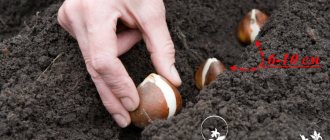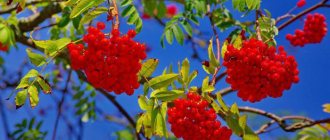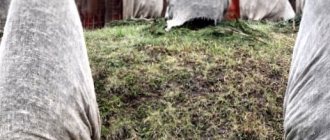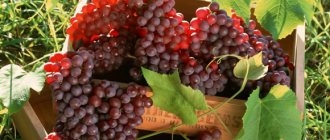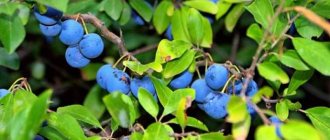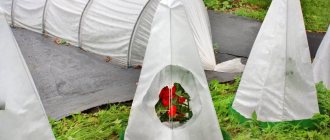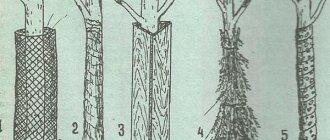How to cover tree seedlings for the winter. Please advise how to protect young fruit trees in winter?
Hello! Sorry for raising this topic again, but I just can’t decide on a way to protect fruit seedlings for the winter from rodents, sunburn, etc. The fact is that our site is new, and I don’t even know yet whether we have mice or hares)) although there is a forest across one area from us. The neighbors don't have fruit trees. And those who have apple trees say that they do nothing with them. But they already have mature trees. We planted seedlings (apple and cherry trees) in the fall. Before the frost, I thoroughly covered them with peat, and I thought I’d calm down with that, since all varieties are winter-hardy. But after reading stories here about rodents and February sunburn, I became concerned. Spruce branches, newspaper, wallpaper, garden tape, tights...))) There are no spruce branches. Pantyhose - in SUCH quantities :) - also not. Wallpaper, newspapers and other paper - many reviews indicate the uselessness of such protection. It's too late to whitewash. I bought garden tape for the trunks - but it’s PVC - and somehow I doubted whether the tree would breathe under this tape (((Can’t I just bandage the trunks of the seedlings with a regular bandage? Or will mice gnaw through it too? A plot in the Moscow region, in Pushchino. Snow has already fallen, the temperature is slowly setting below zero, and my seedlings are all uncovered. One three-year-old apple tree, five columns, and cherries. Dear experienced gardeners!) Please advise how I can protect my small trees in winter!
Best answer from Anatolevna (Irina, Bendery):
Several years ago, in the spring I bought young apple and pear seedlings. They took root well, and in the fall they went into winter rooted, and in the spring, when we arrived at the site, we saw that someone had chewed the bark of the seedlings well. A neighbor said that hares were walking around in winter. The pear tree disappeared altogether, but the apple tree was barely saved. Now, my husband and I wrap the trunks of young trees with simple burlap, and press it down with fine mesh on top.
When should you cover a tree?
You need to strictly adhere to the deadlines for wrapping trees for the winter. To select a suitable period, climatic features are taken into account.
Important!
Early insulation is just as harmful as late insulation.
It is necessary to insulate the planting when the average daily temperature is -10 degrees. You should try to ensure that there is at least minimal protection during the first frost.
Winter protection is not needed in the southern regions. There is a risk of prolonging the growing season. In this case, the plant will die. It is enough to protect the seedling only from rodents.
How to cover apple tree seedlings for the winter. Necessary materials
To cover an apple tree, you need to select materials that allow air to pass through. You can cover it with old stockings, rags, burlap, granulated sugar bags, after first tearing off the film from them. Newspapers are used to cover the trees. One of these materials is used to wrap the trunk and lower branches. It can be covered with agrofibre, as it protects from frost and from mice, rats, and hares.
Previously, in order to cover the trunks of apple trees, they took straw, corn stalks, reeds, spruce and pine branches.
Nowadays, gardeners very often use plastic bottles to cover their trunks. They cut them, wrap them around the trunk, and attach them with ropes. Bottles are good at repelling rodents, as they make noise when there is wind.
Advice! You can also wrap the stem and lower branches with cheap and rough toilet paper in several layers.
You should cover each tree with 3 layers of toilet paper, but you can do more. To prevent toilet paper from flying off in strong winds, it is secured with twine.
To cover apple trees for the winter, you can use foamed polyethylene designed for thermal insulation of pipes. Foamed polyethylene is cut along the seam, wrapped around each trunk, and secured with tape or twine so that it does not fly off. If you cover the apple trees in this way, then rodents will not get to them. This material is inexpensive and can be used repeatedly.
Warning! You can use polyethylene film or roofing felt, but these are materials that do not allow air to pass through, because of this, if they are not removed in time in the spring, burns will appear on the trunk.
Materials used
There is a large selection of materials that can be used to insulate a plant. It all depends on preference. You can give preference to both ready-made and improvised materials.
Finished materials
From ready-made materials, you can use agrofibre and spandbon. Essentially, it's the same thing. For initial protection, agrotextiles of the lowest density are used. It allows air and light to pass through perfectly. Another advantage is lightness. The material can be transported independently. Suitable for the first frosts.
How to protect seedlings from hares. How to protect your garden from mice and hares in winter
It would seem: the harvest has been harvested, the garden has been cultivated and watered, you can rest carefree from late autumn until spring, enjoying the prepared apples and pears and numerous jars of compotes and jam. But no, you can’t! And all because in the cold and hungry season it is necessary to protect fruit trees from hares and other rodents. They are not out of malice, they just want to eat... But this does not make it any easier for either the trees or the owner of the garden: the harvest may not be expected later.
Gardeners, of course, are not sitting idle. And many have already chosen their own way of protecting fruit trees and shrubs from hares and mice. For example, France Khasanovich Khalilov protected the trunks of young trees with a “coat of roofing felt.”
Irina Eremina from Sevastopol showed another - protecting tree trunks using cut plastic bottles.
Advice from Irina Eremina Lyudmila from Kiev proposed an original method of protection by entwining damaged trunks, Lyudmila from Novosibirsk advises adding covering material under the winter to scare away mice, and Ekaterina Fedorovich from Odintsovo chose spunbond to protect trunks. It turns out that there are not so many methods of protection not enough! But which one is best to choose? And is there any universal one that will give an absolute guarantee that not a single rodent’s tooth will touch our favorite trees in the garden... Or does everyone have their own but? Please share your findings and doubts! Rodents are a common problem, everyone will have to solve it anyway. Who will be the first to take the floor today - an excellent student at the dacha or an inexperienced beginner?
Bend down
Pulling a large rose bush or large-leaved hydrangea to the ground and making it lie quietly in place is not easy. In the literature, it is usually recommended to fasten branches to the ground with wooden flyers or press them down with boards or bricks. But the flyers stick in and hold poorly, and bricks placed directly on the branches lead to the latter becoming warm. It is more convenient to stock up on long and durable metal hooks in advance. A good and inexpensive option is to purchase a package or two of welding electrodes and bend them. Moreover, the electrodes must be chosen long and thick - at least 40 cm long and 3–5 mm thick. Suitable hooks can be made from thin reinforcement, a metal rod, and even components from an old prefabricated greenhouse. By the way, it is very useful to wrap the upper arc of each hook with bright electrical tape: this will help to injure the bark less and make it easier to dismantle the shelters in the spring.
To optimize the process, branches that are not too thick are first tied together and bent in a bunch. Instead of ropes, it is convenient to use unnecessary synthetic stockings and tights.
Important : do not delay bending the plants - it is better to do this at positive air temperatures, before the branches become too fragile.
Secrets of shelters. How to protect plants from frost Read more
How to cover pear seedlings for the winter. Preparing pears for winter
Preparation begins with removing rotten fruits, both from the tree and from the area around it and cutting off dry branches. Then we treat the crowns with a urea-based solution.
It is very important to heal wounds so that diseases do not enter them. Therefore, painful areas are removed, and the wounds are treated with copper sulfate and garden pitch.
The roots are very susceptible to frost, so it is important that the soil is moist. It is important to do this if the autumn has been dry. Fertilizers are also needed. Those made on the basis of potassium and phosphorus are best suited.
If the fertilizer preparation contains a lot of nitrogen, it should not be used. It forces new shoots to grow, and in winter they will freeze. This will weaken the tree.
A spoonful of superphosphate and a spoonful of potassium sulfate are added per square meter of soil around the pear. They should be laid out in pre-dug holes 20 cm deep. Fill the fertilizer with water and cover it with soil.
Timely fertilizing in the fall will help protect even young seedlings from the cold. If you fertilize before frost, the tree will bloom better in the spring.
Now let's start pruning the pear. In autumn, all dry and damaged branches should be removed; they will no longer bear fruit in the future. After this, the trunk is sprayed from scab. It is best to use urea.
If the autumn was dry, it is important to water the tree; with a lack of water, the soil freezes more. It will be especially difficult for the tree after a hot and dry summer. If the plant is many years old, you will have to use several dozen buckets of water.
In addition to harmful insects, fruit trees are often attacked by rodents. For example, mice that love fresh bark. The pole should be wrapped with some material for protection.
For example, a plastic mesh or burlap. Another good idea is to coat the bark with a mixture of mullein and clay.
We dilute the ingredients so that the consistency of the mixture is similar to puree. Apply to the bark. It will release an unpleasant odor that will repel mice.
Why is it important to cover a young tree?
Young fruit trees have weak protective functions. The planting has not yet had time to fully adapt to the new growing conditions. An additional danger is rodents. They give preference only to young seedlings. Old plantings suffer the least.
Insulation of plantings protects from the piercing wind. Without shelter, the wood dries out. The spring sun can also harm a young seedling. It starts sap flow. If the temperature is low, the plant gets bark burn.
The growth of the planting and the level of fruiting directly depend on the quality of insulation. Without care, sap flow may not begin in the spring. The plant will have to be removed from the site. It will be impossible to restore it.
How to cover seedlings. How to cover columnar apple trees
Columnar apple tree is a young variety of apple tree, which is becoming more and more popular every year. It is no coincidence that the fruit tree received this name; its appearance resembles a column. The tree has practically no side branches, and the fruits are located along the trunk. A distinctive feature of this apple tree is its dwarf growth.
How to insulate a dwarf apple tree? Dwarf apple trees are susceptible to freezing. After all, frosts near the ground are more severe than at altitude. Increased attention should be paid to apple trees of this variety. In such apple trees, the apical bud often suffers. A bud damaged by frost produces several branches that turn into independent trunks. The appearance of the apple tree is disrupted. To prevent this, you need to cover the crown. Use film or rags, putting covering material on top. It is necessary to cover it with a layer of snow, preparing the columnar apple tree seedling for wintering.
To make the apple tree resistant to gusts of wind, it is recommended to tie a support to the tree. To protect young trees, you need to cover the space near the roots, since the root system can freeze. You can use straw, shavings, sawdust, spruce branches and other materials. Wrap the trunk with available materials: burlap, paper, old rags, nylon stockings, this will repel rodents. The higher part is wrapped in toilet paper or newspapers. Make several layers, strengthening with twine.
With proper measures taken to cover apple trees, the trees will feel good throughout the winter and will not die or freeze under the covering materials and under the snow coat. In the fall they will be able to delight you with delicious juicy apples.
Preparing trees for winter is extremely necessary not only in regions of risky farming, but also in central Russia, even in the southern direction. Light frosts, especially before the first snow falls, can damage the root system of even an adult plant; seedlings and young plantings are also at risk.
Warming cultivated trees for the winter is an important measure to protect garden crops. It will allow you to get a rich harvest even after severe frosts.
What is the best way to wrap the trunks, and what materials are needed?
Gardeners use different methods and materials to insulate young trees for the winter season. There are no uniform standards, but there are favorite methods that have been used for decades by the older generation and have proven their suitability today. The new generation tends to think more broadly, and is constantly inventing new means that are not always beneficial to plants.
Covering with natural materials
Wrapping a tree in natural fabrics such as burlap or jute has its pros and cons. The advantages of this method include the following factors:
- the fruit trunk under the fabric will be able to breathe, the bark is actively saturated with air, and is perfectly insulated;
- Before wrapping the burlap around it, it is advisable to soak it in a solution against pests and rodents; this will additionally repel them.
How to cover seedlings for the winter. How and when to cover trees for the winter in the Moscow region
Fruit trees are prepared for winter depending on the variety and climate zone. The Moscow region is the middle part of Russia. Winters here are different, and it is impossible to predict in advance what frosts are coming. Risks also include heavy snowfalls, sharp winds, and the formation of ice crust on branches. This means we need to prepare for everything. Apple trees are pruned, without regret parting with dry, painful, underdeveloped, improperly growing branches. The cut areas are disinfected with copper sulfate or garden pitch. If you don’t have both at hand, use oil paint. Now you have to water the trees well: you need to pour from 5 (for young plants) to 10 (for mature) buckets of water per 1 square meter. Abundant soil moisture before wintering will prevent dehydration of the plantings and their death from this factor. In addition, wet soil conducts heat well. The apple orchard is watered at the end of October, when the air temperature remains at 2-4 degrees. Water with hoses, buckets, drips. Buckets, of course, are more practical - it’s easier to count the quantity. If significant precipitation falls at this time, watering is abandoned. Potassium and phosphorus fertilizers are applied. For adult apple trees, superphosphate and potassium sulfate are used. The mixture is combined with humus and manure, left on top or buried in the tree trunk circle. Fertilizing will improve the frost resistance of apple trees. The mulch layer should be at least 5 centimeters. Depending on the composition of the soil, they add not manure, but, for example, ash, lime, or dolomite flour. The right thing to do would be to dig up the soil under the apple trees or at least go over it with a rake. Destroy weeds along with pest larvae. Then a wooden structure is built, inside which a mixture of foliage, black soil, and sand is placed. When severe frosts occur, the finished shelter is supplemented with agrofibre, roofing felt or polyethylene.
Shelter No. 1: from rodents
To protect the trunks from rodents, bandage them with polyvinyl chloride film and cover them with roofing felt and spruce branches. If there are hares, moose in the region, or there is a risk that the trees will want to be eaten, for example, by the neighbor's goats, then you need to cover the bark with spruce branches. Moreover, you need to cover the forks of skeletal branches, the crowns of young trees - all these are very living creatures.
Winter means cold and lack of greenery, but this does not mean that pests have stopped doing their job. You need to set up traps for the dangerous mole cricket - dig a hole half a meter deep, put warm manure in it, and then cover it with earth and mark the place with pegs. When severe frosts strike, a hole is dug up and the mole crickets gathered in it die.
How to protect seedlings from hares for the winter. How and how to protect fruit trees from rodents for the winter
The very first step that needs to be taken to protect the garden from the invasion of mice and hares: you need to remove all plant debris, fallen leaves, hay, straw, fruits and vegetables from the garden in the fall. Then you need to carefully cover the compost pile.
However, such methods are not enough; to save your plantings in winter you need to use specific technologies. Let's look at the most popular and reliable ways to protect the bark of apple trees (and other fruit trees):
- Mesh with small cells (plastic or metal). A very reliable and convenient way to protect tree bark from mice and hares. Animals cannot overcome such a barrier, but the tree has access to sunlight and air, and there is no danger of heating. It is very simple to make and remove the structure. The only negative: you will have to spend money buying such material at a garden center or hardware store. Using the mesh is very simple: you need to wrap the tree trunk and skeletal branches in the form of a cylinder, the mesh should be buried 10-15 centimeters so that mice cannot dig under it.
Important! The cells in the mesh must be very small, otherwise mice will easily penetrate them!
- Nylon products (tights, stockings). The method has been used for decades, and despite its long history, it does not lose its effectiveness. You need to tie the trunk with nylon on a dry, clear day at the first frost in late autumn. For greater efficiency, you can soak nylon with a small amount of the drug “Pugach”.
- Spruce or pine spruce branches. The branches of evergreen crops are very good at preventing the invasion of hungry animals. Firstly, they are repelled by the smell of conifers, and secondly, sharp needles prevent them from getting close to the bark. The technology of use is simple: you need to tightly place the spruce branches around the trunk with the needles down, and then secure them tightly with a rope. However, remember that you cannot use forest resources recklessly and tear spruce branches from trees! In order to respect nature, you can take it from the ground, for example, after sanitary felling, you can use last year’s branches.
- Branches of other crops (juniper, rose hips, hawthorn, raspberries, blackberries). If you perform autumn pruning of the listed crops, it is better to cover the trunk with them instead of spruce branches. The branches are also secured tightly around the trunk, leaving no free space for an animal to get into.
- The main protection specifically from hares can be a continuous fence around the entire perimeter of the site. The fence can be made of corrugated sheets or chain-link mesh. Moreover, such a fence should not have any cracks or holes into which rodents can get.
- Special paint for trees to protect rodents (as a rule, it also protects the bark from sunburn, frost, and pests). You can purchase it at specialized garden stores. The paint should be used at above-zero temperatures on a dry day shortly before the first frost.
- A mixture with a bright smell. Instead of buying ready-made paint, you can make a fragrant mixture with your own hands. The strong smell will keep animals away throughout the winter. For example, you can prepare a mixture according to the following recipe: clay and mullein (half a bucket of each substance) are stirred to a creamy consistency, 50 grams of creolin are added to them, mix thoroughly again. It is also better to lubricate the trunks with the mixture on a dry day before the first frost.
- Smelling sawdust in the tree trunk circle. Some bright smells can scare away animals. It is effective to make a solution (5 grams of creolin or carbolic acid per 1 liter of water), soak sawdust in it and spread it around the tree trunk.
- Fragrant herbs in the tree trunk. For additional protection, you can place aromatic herbs in the tree trunk circles that will repel animals. For example, lemon balm, mint, wormwood, tansy, basil, cilantro. This method is best used in combination with other methods described above.
Insulation of mature trees
Mature, large trees need protection if the prognosis is unfavorable, they have suffered diseases this year. A small shelter is always desirable, since this will allow you not to lose the achieved harvest volume even under the most unfavorable conditions in the next period. And if winter frosts are difficult to damage adult plants, then the first cold without snow, late spring sub-zero temperatures are even more dangerous.
Preparation
Preparing adult fruit trees for the winter should begin with pre-treatment. First of all, you need to remove the entire harvest, be sure to dispose of all rotten, spoiled fruits. Fallen leaves need to be raked. They can become a source of soil contamination and new shoots in the spring. You also need to take care of pests.
An effective measure to prevent infection will be treatment:
- copper sulfate solution;
- lime concentrate;
- a weak solution of potassium permanganate.
If the insulating material is not used for the first time, after storage it must be dried and treated with the same composition to prevent contamination. To prevent rodents from getting into the shelter and roots, you can use something as simple as coffee grounds. The pungent odor repels even harmful slugs and snails and large animals.
All of them come to gardens in winter in search of food. Whitewashing with a special compound or lime will also make it difficult for rodents to access the tasty bark. The enemies of wood are small insects; ants will not be able to penetrate into the cracks and harm the plant. In addition, this measure will avoid cracking of the rough bark of an adult trunk due to temperature changes.
Insulation of the tree trunk circle
Mature garden trees need shelter around the trunk. Developed roots can be damaged by frost, so be sure to mulch the soil. Pre-treat the soil with a weak solution of fungicide. There are permanent and dynamic mulch.
Permanent also performs a decorative function, but in cold regions it is recommended to first perform dynamic treatment, for which they are suitable:
- peat;
- sawdust;
- compost;
- manure;
- humus;
- hay.
I lay manure and finished compost in a layer no thicker than 6 centimeters. Otherwise, rotting may begin. All other materials can be laid in a layer of up to 10 centimeters. Seedlings are processed in a similar way.
You need a little less peat for mulching; polka is a heavy and dense material.
Permanent mulch is a covering of the soil with durable materials with good thermal insulation properties. For example, gravel with different size fractions, coarse sand, natural stone chips.
If it is desirable to cover dynamic mulch with spruce branches or agrofibre, then permanent mulch no longer needs further strengthening. The only exception is the northern regions, where multi-layering is needed to protect against severe frosts.
Insulation of trunk and branches
Adult plants need to be completely insulated only in the northern regions. If temperatures do not fall below minus 30 degrees Celsius, a strong trunk with thick and rough bark will cope with the load on its own. This kind of wooden insulation is already enough. However, if the plant has been infected, weakened, or recently replanted, it makes sense to cover the trunk additionally, but then remove all materials a little earlier to ensure timely awakening in the spring.
Since it is no longer possible to build a protective frame around the trunk due to the size of the plant, it is necessary to use plastic materials and canvases. For example, synthetic or natural pipe insulation is a good choice. It will protect from the cold and from rodents, even from wild hares.
Such materials are used in pipeline installation because they are durable and can be used in the garden for up to ten years. If the material is sold in the form of large rolls, it can not be cut into strips, but wrapped entirely around the trunk. Secure the outside with twine or regular tape. Treat large branches in the same way.
Question of legality
When cutting spruce branches, you should know that, according to the Forestry Regulations, spruce branches can only be collected from fallen trees in forest clearing areas. This also applies to festive trees for the New Year.
However, there is a Forest Code, according to which gardeners have the right to freely use forest resources and collect them. In this case, foresters cannot interfere with gardeners, and the spruce plant (the photo shows it) can be collected without hindrance. But whether it’s worth the risk and exposing yourself to unpleasant meetings with forest inspectors, each gardener will have to decide for himself.
Fruit tree pruning
This procedure is recommended to be carried out in dry weather before the onset of winter frosts. If the temperature has already dropped below 10 degrees, then it is better to postpone pruning until the weather warms up. In frosty weather, wood becomes very fragile and sensitive. After pruning, cracks and wounds may occur, which can lead to disease and death of the plant. Sanitary pruning of trees before cold weather involves ridding the plant of diseased, broken and dry branches. It is also recommended to cut off branches that grow inside the crown. Pruning should be done very carefully so that the cuts are even, without tearing the bark. Do not forget about treating the cuts with special means to avoid the proliferation of fungal spores on them.
Hardening off trees and mulching the soil
Why is hardening off trees necessary? This process allows plants (especially young ones) to get used to hypothermia and exposure to low temperatures, which allows them to be well prepared for winter. As part of hardening, it is necessary to cut off the top layer of soil near the tree trunk up to 5 cm thick. It is recommended to store the cut soil in a dry place. As soon as the first frost occurs, the soil layer should be returned to its place. Thanks to this method, apples and pears will be able to survive even the coldest winters without damage.
The soil should be mulched using dry bulk materials near the root system of apple, pear and stone fruit trees.
How to preserve perennial rhizomes
Rhizomes of perennials (phlox, hosta, heuchera, miscanthus and others) come in perforated bags, placed in a dry nutrient substrate. What you need to do with them after receiving them:
- Open the package and let the rhizomes “breathe” at natural temperature.
- If the roots are kept indoors at temperatures above 20 C, then they must be planted in the soil no later than a day later.
- We recommend using containers and flower pots for planting - it's no big deal. Rhizomatous perennials tolerate numerous transplants well and by the time they move into the garden they will have time to produce good growth.
- You need to take a pot of small diameter, pour a little peat on the bottom, place the division strictly vertically and carefully straighten the roots, sprinkle with peat, compact it a little and moisten it. Place the pot in a dry room with a temperature no higher than three degrees.
It is under these conditions that the plant’s root system will begin to develop. At the end of March - beginning of April, you can safely put the pots in a warm, bright room in order to plant the grown plant in a permanent place in May. This way you will protect the rhizomes from damage, and give the plant more time to grow and develop. Note:
- Plants with thin roots, such as phlox, are best planted immediately (regardless of the size of the buds). If stored for a long time, they can dry out and become unviable.
- After planting, it is better to place all plants (peonies, phlox, etc.) in a cool, bright place. The loggia is perfect. But you absolutely can’t put it on the floor! There's not enough light there. Raise the plants higher, at least on a stool.
Important! The resulting rhizomes can be placed in the refrigerator (temperature -1-3 C) and kept for as long as necessary before planting. This is true if you receive the parcel late in the fall and it will be too late to root the plants.


